After Nickeil Alexander-Walker left the Minnesota Timberwolves, the team opted not to make any moves to replace him. Sure, they added Johnny Juzang, but he's only on a training camp deal, and he won't play big minutes even if he makes the roster. Undoubtedly, this signals organizational belief in the Wolves' young talent, especially Terrence Shannon Jr.
The Illinois product didn't play much in his rookie season. However, in the limited minutes Shannon played, he thrived. After being inserted into the rotation during the Western Conference finals, Shannon racked up 35 points in a three-game stretch. He also scored an impressive .41 points per possession.
By all accounts, Shannon is well-positioned to take on a bigger role and help fill the void Alexander-Walker left behind, but the 25-year-old needs to improve in some key areas.
Shannon has a different playstyle than Alexander-Walker
Alexander-Walker had a well-rounded impact. He provided spot-up shooting, secondary playmaking, and elite on-ball defense. While Shannon has shown flashes in these areas, he still needs to improve. Shannon's primary strengths are scoring and high-energy play.
The 6-foot-6 wing is built like a tank but has impressive speed and athleticism. This allows Shannon to attack the rim at a high rate. He is also a gifted isolation scorer who can score at all three levels. Shannon's high-energy playstyle allows him to thrive in transition.
Spot-up shooting, playmaking, and on-ball defense are key areas for growth for Shannon
Considering their slightly different playstyles, it's possible that Shannon simply gives the Wolves a different element. However, the Wolves are used to a specific skill set from their most trusted bench wing.
Spot-up shooting will always be vital for role players. Notably, last year, NAW shot 42.5 percent on catch-and-shoot 3-pointers while TSJ shot 34.6 percent. When playing with Anthony Edwards and Julius Randle, spot-up shooting will be especially crucial. Undoubtedly, this is a key area of improvement for Shannon, and getting more reps as a spot-up shooter should help him.
Secondary playmaking was another key area of Alexander-Walker's impact. Shannon has shown flashes of this ability, and he had a lot of ball-handling duties in college. Still, he'll have to prove that he is capable of handling the ball and playmaking at a consistent rate in the NBA. This will be vital given the Wolves' roster needs.
Shannon is certainly a positive defender. He can guard multiple positions and is disruptive off the ball. This leads to an opportunity for him to score in transition. Regardless, Shannon will need to prove himself as an on-ball defender, an area in which Alexander-Walker thrived. Having an on-ball stopper off the bench has helped the Wolves have elite defenses in recent years.
Overall, Shannon does need to grow in some areas to maximize his minutes. Nevertheless, with more minutes, it's reasonable to expect these improvements from the 25-year-old.
